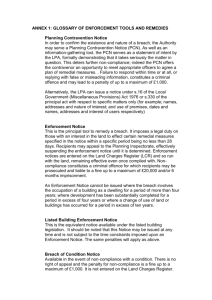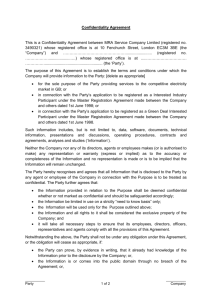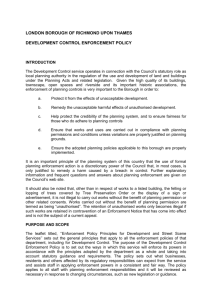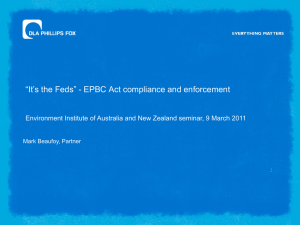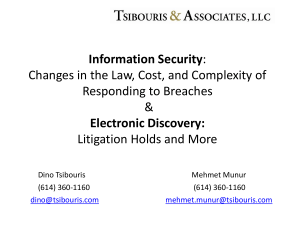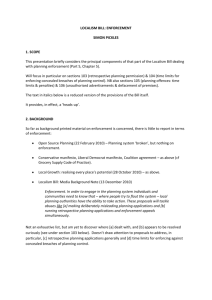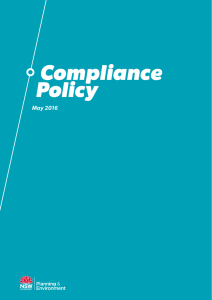Enforcement Enquiry Guidance
advertisement
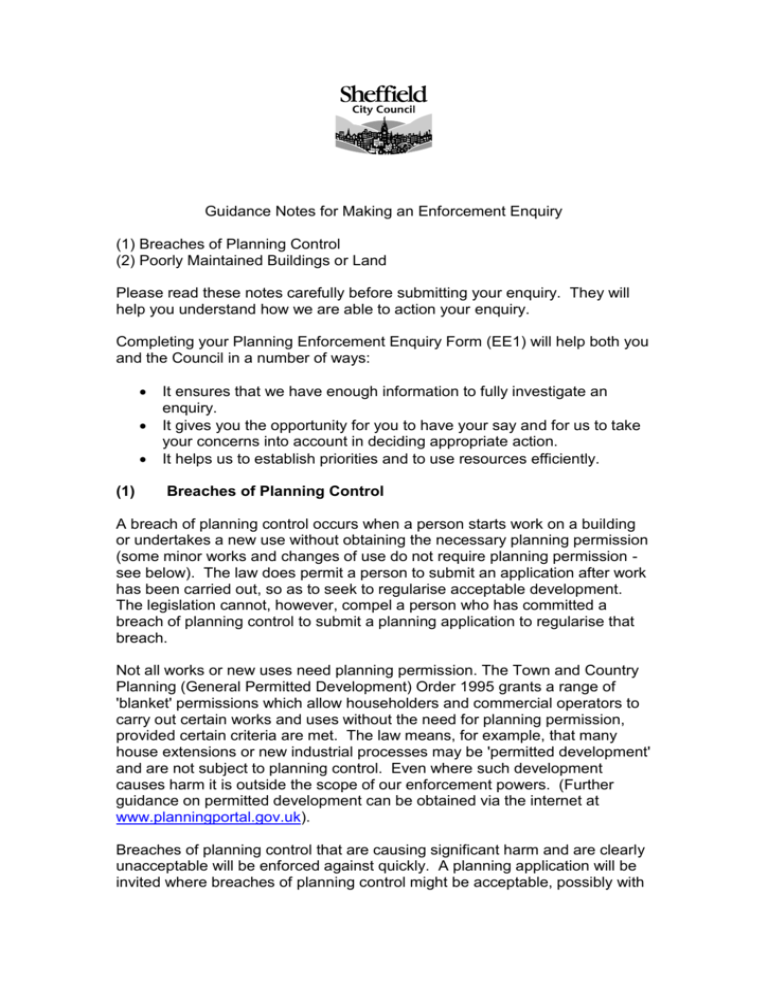
Guidance Notes for Making an Enforcement Enquiry (1) Breaches of Planning Control (2) Poorly Maintained Buildings or Land Please read these notes carefully before submitting your enquiry. They will help you understand how we are able to action your enquiry. Completing your Planning Enforcement Enquiry Form (EE1) will help both you and the Council in a number of ways: (1) It ensures that we have enough information to fully investigate an enquiry. It gives you the opportunity for you to have your say and for us to take your concerns into account in deciding appropriate action. It helps us to establish priorities and to use resources efficiently. Breaches of Planning Control A breach of planning control occurs when a person starts work on a building or undertakes a new use without obtaining the necessary planning permission (some minor works and changes of use do not require planning permission see below). The law does permit a person to submit an application after work has been carried out, so as to seek to regularise acceptable development. The legislation cannot, however, compel a person who has committed a breach of planning control to submit a planning application to regularise that breach. Not all works or new uses need planning permission. The Town and Country Planning (General Permitted Development) Order 1995 grants a range of 'blanket' permissions which allow householders and commercial operators to carry out certain works and uses without the need for planning permission, provided certain criteria are met. The law means, for example, that many house extensions or new industrial processes may be 'permitted development' and are not subject to planning control. Even where such development causes harm it is outside the scope of our enforcement powers. (Further guidance on permitted development can be obtained via the internet at www.planningportal.gov.uk). Breaches of planning control that are causing significant harm and are clearly unacceptable will be enforced against quickly. A planning application will be invited where breaches of planning control might be acceptable, possibly with amendment. This will enable the issues to be thoroughly tested, including consulting local people. We have signed up to the 'Enforcement Concordat', which sets national best practice standards for planning enforcement. The Enforcement Process We must act within the framework of legislation and advice provided by the Government. Unlike theft, a breach of planning control is not a criminal offence; its status is 'unauthorised'. If a breach has occurred and retrospective planning permission isn’t obtained the Council must decide whether to take enforcement action to rectify the situation. It may be that the unauthorised activity or building is not thought to have a harmful affect in terms of the issues which planning can consider and it is decided to take no further action. A breach only becomes an offence if it continues after an Enforcement Notice has been served and the period allowed for compliance has expired. An Enforcement Notice will identify the breach of planning control and state what is necessary to remedy the breach. A Notice could, for example, require an unauthorised use to cease or for building works to be demolished. When taking Enforcement action the Government requires us to be able to show that the breach causes clear harm. This is especially important as the legislation provides any person served with an Enforcement Notice the Right of Appeal. To successfully defend the Notice we must be able to provide evidence of harm. If we cannot, then the Notice will fail. It is therefore important for you to be as clear as possible in describing the harm caused by the breach (see question 5). (2) Poorly Maintained Buildings or Land Section 215 (s215) of the Town & Country Planning Act 1990 gives the Council, as the Local Planning Authority (LPA), the power, in certain circumstances, to take steps requiring land, including any buildings within that land, to be properly maintained when the condition adversely affects the amenity of the area. A s215 Notice may be served setting out the steps that need to be taken, and the time within which they must be carried out. The Council also has the power under s219 to undertake the work itself and to recover the costs from the landowner. The use of s215 by the Council is discretionary and it is therefore up to the Council to decide whether a notice under these provisions would be appropriate in a particular case. Clearly the level of maintenance has to be exceptionally poor to justify the Councils intervention. Section 215 is effectively used on large vacant industrial sites, town centre street frontages, rural sites, derelict buildings, and semi-complete development as well as on very dilapidated residential properties. We will assess any poorly maintained buildings or land drawn to our attention for possible action. Planning Matters - What we can and cannot consider In deciding whether to take Enforcement action the Local Planning Authority can only take into account matters relevant to land use planning. It cannot be used to protect one person's private or commercial interest against another. Issues the Local Planning Authority cannot investigate Boundary Disputes Height of hedges and trees Internal alterations to houses (unless a listed building) External security lights fixed to houses Similarly, it would not be appropriate for the Local Planning Authority to take into account matters that are covered by other legislation, for example, complaints of noise or the improper use of the public highway. Such complaints are best directed to the Police or Environmental Protection Service. Any such issues raised will be passed on to the relevant department. You should be aware of the following: The subject of your enquiry is public information, but not your name and address Your name and address will be kept confidential.
